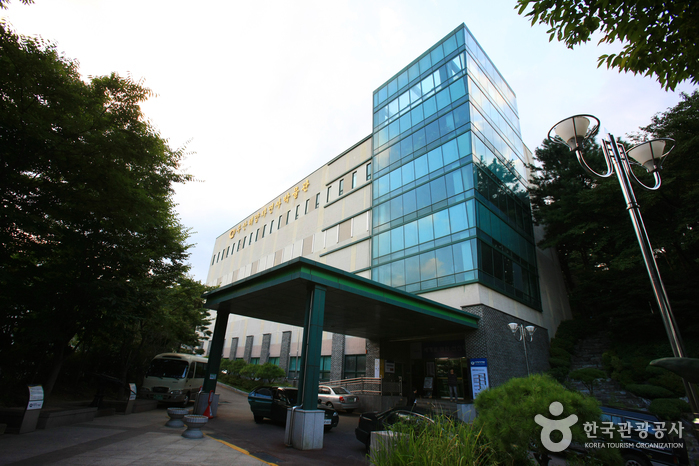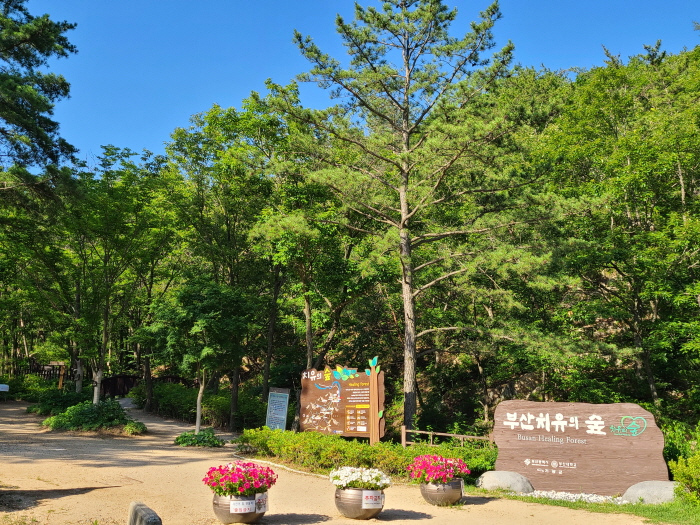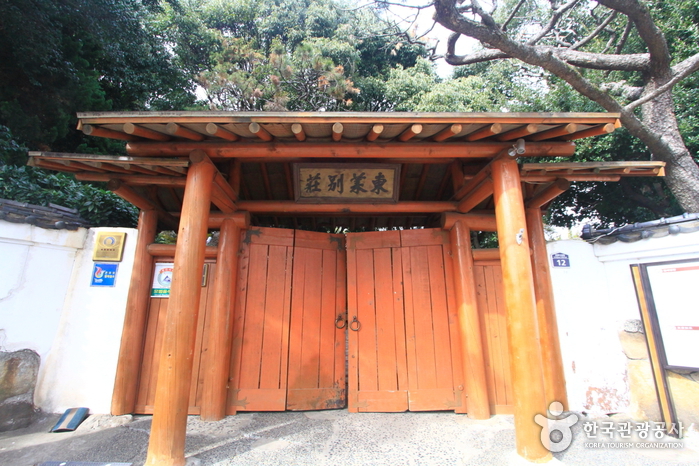Olive Young - Pusan Nat’l Univ. Station Branch [Tax Refund Shop] (올리브영 부산대역)
12.2Km 0 2024-04-22
46, Geumjeong-ro 68beon-gil, Geumjeong-gu, Busan
-
Busan Marine Natural History Museum (부산해양자연사박물관)
12.3Km 24524 2021-06-09
175, Ujangchun-ro, Dongnae-gu, Busan
+82-51-553-4944
Opened on June 10, 1994, the Busan Marine Natural History Museum is the first and largest museum of its kind in Korea. The museum features some 25,000 marine specimens from over 100 countries around the world, including rare living species and those native to Korea. The museum opened a second exhibition hall in April 2003, and launched the Busan Fishing Village Folk Museum on February 23, 2007.
Busan Healing Forest (부산 치유의 숲)
12.4Km 0 2024-01-05
101 Cheolmacheon-ro, Gijang-gun, Busan
Busan Healing Forest is the first “healing forest” to be founded in the Gyeongsang-do region. This place is where visitors can reflect on emotions and relax through various wellness programs surrounded by nature and healing energy. Busan Healing Forest is 153ha in size, and it takes about 40 minutes to walk around the central trail starting from the visitor center at the entrance. Programs tailored to various audiences are operated in multiple places found along the central trail: the Forest Library, Mind Sharing Site, Forest Healing Yard, Forest Meditation Site, Pine Wind Bathing Site, and Prenatal Education Forest.
Gimhae Astronomical Observatory (김해천문대)
12.5Km 12405 2022-12-29
254, Gaya thema-gil, Gimhae-si, Gyeongsangnam-do
+82-55-337-3785
Gimhae Astronomical Observatory opened on February 1, 2002 as part of the Millennium Commemorative Project that started in December 1998. It was built to satisfy the general public’s curiosity about the universe and celestial bodies, inspire young people, and give everyone a unique, memorable experience. The observatory is shaped like an egg, in memory of the legend of King Kim Suro, the founder of the Garak Kingdom, according to which the king was born from an egg.
It is said that the queen of King Suro, Heo Hwang-ok, was a princess from the Indian country of Ayuta. Since sophisticated navigation equipment had yet to be invented, it can be assumed that she found her way to the Garak Kingdom by following the stars. It is also said that a prince of the Garak Kingdom built an observatory on the highest point of a mud fortress in Jinrye in order to make astronomical observations. The place is still referred to as Bibidan, which means a place to watch the stars.
These historical facts indicate the stars were very important to the Gaya, an ancient kingdom established mainly in the Gimhae area. The peak of Bunseongsan Mountain, where the observatory is located, offers sweeping views of the entire area of Gimhae. The night sky of Gimhae offers a breathtaking sight.
Miryang Dwaeji Gukbap (밀양돼지국밥)
12.5Km 0 2024-02-23
91 Inje-ro, Gimhae-si, Gyeongsangnam-do
Miryang Dwaeji Gukbap is a renowned dwaeji gukbap (pork and rice soup) establishment located in Eobang-dong, Gimhae-si. Recognized among the top 100 recommended restaurants for Gimhae tourism by the city, this eatery has become so popular that visitors often queue to taste its offerings. Standard accompaniments include buchu muchim (chive salad), chili peppers, garlic, and kimchi. In addition to dwaeji gukbap, visitors can enjoy suyuk (boiled pork slices). Nearby attractions include Gimhae Gaya History Park, Gaya Land, and Bunseongsan Mountain.
Subaekdang Dwaejigukbap Gimhae Branch (수백당돼지국밥김해점)
12.6Km 0 2024-01-24
109 Inje-ro, Gimhae-si, Gyeongsangnam-do
Subaekdang Dwaejigukbap specializes in dwaeji gukbap (pork and rice soup) with boiled pork slices and rice in a broth simmered with pork bones. Its owner is said to have visited 96 pork soup restaurants across the country to study the taste and make the best pork and rice soup. The rich, refreshing broth made by boiling pork backbone for a long time is excellent. This restaurant also serves sundae gukbap (sundae and rice soup) made with premium Berkshire pork. The Maneul Suyuk Baekban (garlic and boiled pork slices set menu), one of its signature items, is made with pork belly that anyone loves and topped with garlic sauce.
Bunsanseong Fortress (김해 분산성)
12.6Km 25717 2023-01-18
210-162, Gaya-ro 405beon-gil, Gimhae-si, Gyeongsangnam-do
+82-55-330-3925
Bunsanseong Fortress was constructed in the 3rd year of the reign of Goryeo's King U (1377) by Magistrate Park Wi to defend against foreign enemies, but it was destroyed during the Japanese invasion of 1592. The fortress we see today was reconstructed by Magistrate Jeong Hyeon-seok in the 8th year of the reign of Joseon's King Gojong (1871). However, it is estimated that it was first built during the days of Gaya. It is a temoe-style fortress with rocks piled up like a long band at the peak of Bunsan from which downtown Gimhae, Gimhae Plains, the Nakdonggang River and the South Sea are all in a single, panoramic view. Today, fortress walls remain stretching for some 900 meters on the slope towards the city and, inside the fortress, there are two gate sites in the south and north, an auxiliary gate on the west, a well site and several other building sites. The exact length of the remaining fortress walls is 929 meters and the average x_width is about 8 meters.
Inside the fortress lies Haeeunsa Temple, which was built to pay respects to Queen Heo of Garak who had come from the sea, according to stories. The temple also enshrines portraits of King Suro and Queen Heo that were painted during the Joseon dynasty. During the Japanese invasion of 1592, monk soldiers were stationed at this temple.
The fortress is more popularly called "Manjangdae" by Gimhae locals, and this name originated from the description, "A tall tower 10,000 (man) gil in x_height," granted by Daewongun in the Joseon dynasty for this advanced base that defeats Japanese invaders. A writing of "Manjangdae" written by Daewongun himself as well as his stamp are engraved on a rock behind a beacon that was restored in 1999.
Dongnae Byeljang (동래별장)
12.6Km 11874 2020-04-28
12, Geumgang-ro 123beon-gil, Dongnae-gu, Busan
+82-51-552-0157
Dongnae Byeljang in Busan is a villa with over a century of history. The villa boasts a large garden infused with Korean and Japanese styles, pine trees that are 200 to 300 years old, as well as a pagoda and a traditional-style house that are of cultural heritage value. Also, it has long been the cradle of song and dance heritage. Today, it is well known for its Korean restaurant, Song Hyang, that serves traditional royal cuisine. The combination of old charm with a unique dining experience makes Dongnae Byeljang a popular venue for various special events and family gatherings.
Geumgang Park (금강공원)
12.6Km 43481 2024-03-05
155 Ujangchun-ro, Dongnae-gu, Busan
+82-51-860-7880
Geumgang Park is a park located at the foot of Geumjeongsan Mountain, near the Dongnae Hot Springs Area. It features lush forests of naturally grown trees, majestic cliffs, and valleys creating breathtaking scenery. Throughout the park, there are numerous historical relics and ruins. A cable car is available for visitors to ascend Geumjeongsan Mountain, offering panoramic views of downtown Busan. Nearby attractions include the Busan Folk Art Center, Busan Marine Natural History Museum, and Geumgang Botanical Garden.
Nokcheon Hotel [Korea Quality] / 녹천호텔 [한국관광 품질인증]
12.7Km 158 2020-12-12
31, Geumganggongwon-ro 26beon-gil, Dongnae-gu, Busan
+82-51-553-1005~9
Busan’s Dongnae Hot Springs is an old and famous hot spring whose historic records trace back to Samguk Yusa, in the 13th Century CE. Its magnesium-rich 65℃ hot springs water is said to be highly effective toward the treatment of neuropathic pain, dermal disorders, and stomach disorders. Nokcheon Hotel’s history traces back to Nokcheonjang, a hot springs facility constructed in 1962 with Dongnae Hot Springs water. The hotel itself was constructed in 1980. All rooms in Nokcheon Hotel are furnished with large bathtubs, allowing visitors to enjoy their hot springs bath in private comfort. Interestingly enough, the bathrooms are furnished with buckets, stools, and other quintessential items of Korean public baths. The room interior tends toward simple elegance, with beige interior and wooden furniture. A variety of rooms are available, from Double and Twin rooms to Ondol (heated floor) Rooms and Family Rooms, accommodating from 2 to 8. The Family Room has two well-equipped baths, making it perfect for large families. The hotel is also home to a Korean restaurant specializing in freshwater clam soup and abalone rice porridge, a café, and a 24-hour convenience store. The lobby has a number of massage chairs for relaxation.
Dongnae is also famous for its delectable food. Eat Streets like the Gomjangeo Alley, Dongnae Green Onion Pancake Alley, and Sajik-dong Eat Street are great destinations for foodies, while Oncheoncheon Stream, Geumgang Park Cable Car, and the Site of Dongnaeeupseong Walled Town area also within easy reach.
![Olive Young - Pusan Nat’l Univ. Station Branch [Tax Refund Shop] (올리브영 부산대역)](http://tong.visitkorea.or.kr/cms/resource/46/2888746_image2_1.jpg)




![Nokcheon Hotel [Korea Quality] / 녹천호텔 [한국관광 품질인증]](http://tong.visitkorea.or.kr/cms/resource/13/2636213_image2_1.jpg)
 English
English
 한국어
한국어 日本語
日本語 中文(简体)
中文(简体) Deutsch
Deutsch Français
Français Español
Español Русский
Русский